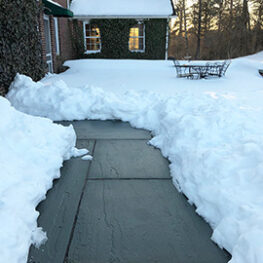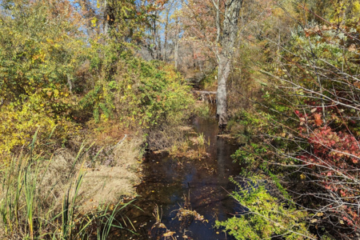
Too much salt in your diet can lead to health problems, as any doctor will attest. The same is true for too much salt on roads, parking lots, driveways and sidewalks – but the resulting health problems are with ecosystems and drinking water supplies.
This time of year, as snow falls and melts, rock salt gets washed onto surrounding land. From there, it can make its way into streams, rivers, lakes, reservoirs and underground aquifers – and eventually drinking water.
Obviously, driver safety comes first and no one is advocating for not treating roads to prevent ice. But for years, Raritan Headwaters Association has advocated for smarter use of road salt in winter. Our mission is to protect clean water in the rivers, streams and underground aquifers in the upper Raritan River watershed.
The cheapest and most commonly used road salt is sodium chloride, the same stuff found in kitchen salt shakers. Not only can it contaminate drinking water, but it also kills roadside plants, damages soil and harms the aquatic life in nearby streams and rivers.
Data collected by Raritan Headwaters shows that chloride levels are impacting streams and groundwater at some locations within the watershed. Once salt is in a pond, lake or aquifer, it is very difficult and expensive to remove it.
Beyond being bad for the environment, salt hurts pet paws, damages leather shoes and boots, causes concrete to crumble, damages floors in houses and corrodes the metal in cars.
One solution to the problem is brine, which is rock salt diluted in water. Brining significantly reduces the amount of sodium chloride needed to keep roads from icing. Fortunately, many local public works departments have switched to spraying brine on their roadways before snowstorms instead of scattering rock salt.
Another plus is that brining reduces waste, saving money for towns. One study showed that 30 percent of rock salt spread on roads immediately bounces off or is blown away by wind and vehicles. Any local resident whose town still spreads rock salt should ask them to consider switching.
Homeowners and business owners can do their part to help reduce the damage caused by salt by using more environmentally-friendly deicers on driveways, walkways and sidewalks. Here are some options:
- Calcium chloride costs significantly more per pound than rock salt, but you can use a lot less of it, so the cost per application equals out. Plus, some rock salt uses cyanide as an anti-caking agent, whereas calcium chloride usually does not have an anti-caking agent.
- A better option would be magnesium chloride. It is less toxic than either rock salt or calcium chloride because it contains less chloride. It is more expensive than either rock salt or calcium chloride, but can be a very good option for relatively smaller applications.
- An even better option is calcium magnesium acetate. It contains no chloride, so it is significantly safer than any of the previous options. It’s more expensive than rock salt, but is a much safer choice to protect local waterways and plant communities. It can be used cost-effectively on places like sidewalks or driveways.
- Sand or grit are also options. They are relatively low cost, but they require judicious use because they can end up clogging storm sewer systems.
- Maybe we should follow the lead of city officials in Krakow, Poland, who have been sprinkling used coffee grounds from restaurants onto sidewalks to improve traction. Not only is this a fabulous way to reduce waste, it also fills the air with a pleasant coffee aroma!
We’ve gotten a lot of snow so far this winter, and could get more over the next two months. Winter snow and ice present serious challenges, but for the sake of clean water and healthy ecosystems, please choose the most environmentally-friendly options for deicing.



